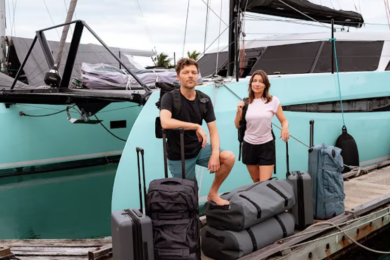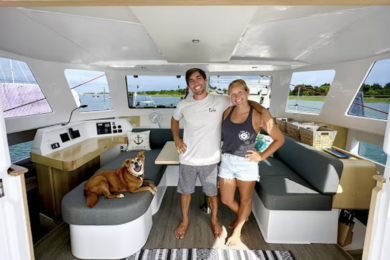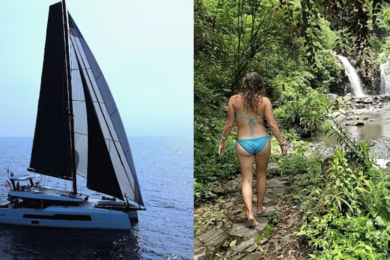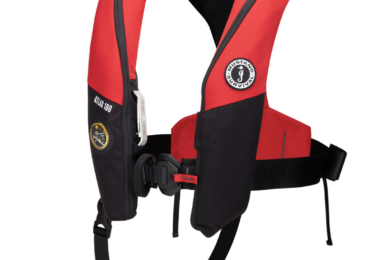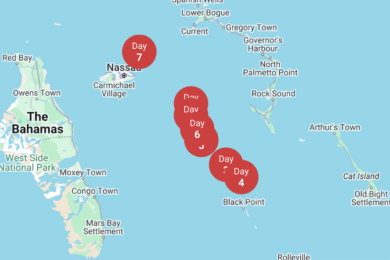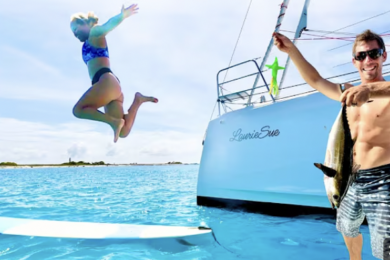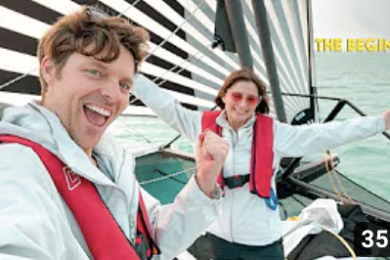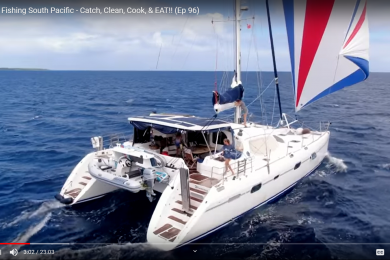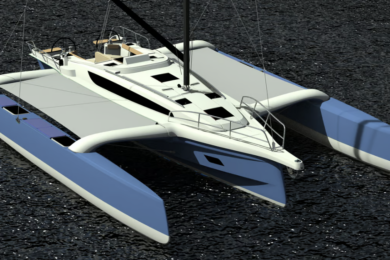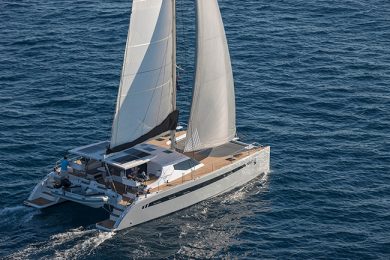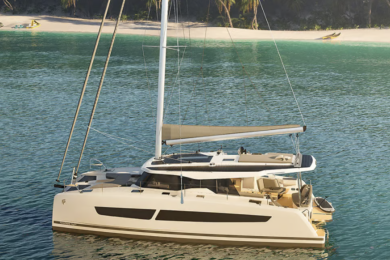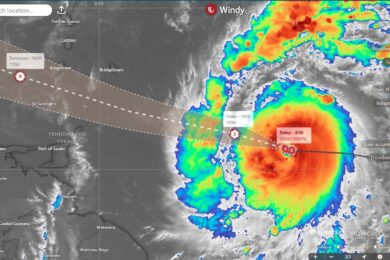Yes, it happens—multihulls broach, sometimes into a capsize (Published Spring 2011)
The 48-foot catamaran was quickly gaining on its competition, just south of St. Maarten. As a cloud went overhead, the wind gusted a few knots. The boat responded with an increase in speed, and the apparent wind shot forward, further adding to the boat speed. Suddenly, the rudder snapped under the increase in load, and the boat skidded to weather. And as the continuing acceleration lifted one hull out of the water, the wetted surface was cut in half: less friction, more speed still again. In a flash, things weren’t looking too good.
“We’re going up!” came from the helmsman, and—rudderless—there was nothing he could do about it. The headsail trimmer quickly dumped the wind out of the jib, and the boat immediately settled back down, speed instantly dropping. The cat was right-side-up, and everyone was okay. Only one of the rudders was a little worse for the wear, dragging behind the now-slowed cat.
IT HAPPENS…BUT NOT OFTEN
Yes, multihulls do occasionally broach, and they can go upside down. Here’s a news flash: so do monohulls. Like it or not, I have to confess that I’ve been on monohulls that were knocked down and sometimes—rarely—even flipped over. Prior to the 1985-86 Whitbread Round the World Race, Drum managed to lose its keel, capsizing in the 1985 Fastnet Race. The boat was put back together and almost lost the keel a second time on her way south to Cape Town. In the following Whitbread Race, Martella lost her keel off the coast of Uruguay. It happens. On rare occasion.
If you were to graph the stability curve of various types of sailboats, plotting the angle of heel, you would quickly see that monohulls are much less likely to invert. Catamarans typically have a somewhat sharper stability curve than trimarans, implying that it’s marginally more difficult to capsize a tri than it is to invert a cat. Once inverted, multihulls are quite stable upside-down, but re-righting is not completely unheard of, even in big multihulls. Rich Wilson and Steve Pettengill can attest to that feat after they were capsized and re-righted during their attempt at rounding Cape Horn in 70-foot seas aboard Great American, a 60-foot tri. By all accounts, it wasn’t a pleasant experience.
Those are the horror stories. They grab the headlines and lurk amongst our fears. But they’re certainly not inevitable, and many, many thousands of multihull sailors never even approach a capsize, much less experience one.
PUSHING THE LIMIT
Of course, while racing multihulls I tend to push the limits on things. Racing cats are meant to be raced with one hull out of the water, controlling the amount of heeling by steering closer to the wind or slightly off the wind in order to keep the weather hull out of the water by a few inches or feet, depending on the size of the boat. While cruising, I’m much more conservative, and try to avoid flying a hull. But in all circumstances, you want to know where the limits are. And the limits are often defined by the conditions in which you’re sailing.
In gusty or shifty conditions, you will want to add a margin of safety by assuming that you will get a few extra knots of wind from time to time or that the wind direction may shift a few degrees, unexpectedly powering you up. Expect the unexpected when the wind conditions are unstable, and avoid the problems before they occur. “An ounce of prevention is worth a pound of cure.”
In uncertain conditions while multihull cruising, conservative sailing can be worth quite a bit more. Putting that extra reef in the main or using the smaller jib may slow you down a little bit, but it may also mean that everyone rests much more easily, enjoying the ride far more. Being able to quickly dump the sails is also at times a critical help.
Typically, when leaving a loaded line on a self-tailing winch, I will put an extra wrap of line around the winch after the line comes out of the self-tailer. That helps to ensure that the line won’t come out of the tailer, and someone won’t inadvertently kick the line free. But if I’m encountering uncertain conditions and think that I might need to dump the jib or mainsheet quickly, I sometimes reverse the direction of the line as it comes out of the self-tailer. One quick jerk on the sheet, and the line is immediately free to be eased. Similarly, I may trim my sails somewhat differently in gusty conditions, inducing a bit more twist in the top of the main in order to de-power the top of the sail and have less lateral load applied to the top of the rig.
THE ROLE OF SEA STATE
It’s not just the wind that can provide uncertainty, of course. The seas will play their role, as well, and in fact, that role may dominate the role the wind plays. At a point in heavy weather conditions, it becomes extremely important to set your multihull up conservatively for the sea state. If I have daggerboards, I will usually retract the leeward board, leaving the weather board partially down. If a wave starts to pick up my weather hull, the board comes out of the water, and the leeward hull is more free to slide sideways down the wave rather than “tripping” on the leeward board and capsizing.
Whether I’m broad reaching or close reaching, as the seas pick up, I remain aware of the angle that the waves are hitting the boat. I never want to have the waves hitting me broadside on the beam in a steep seaway. Beam on to the seas in large seas means that I’m more likely to get rolled rather than pushed down the wave. And if there is any doubt about that because I’m truly in storm conditions, I will drag warps.
During the New York to Melbourne, Australia speed record that Rich Wilson and I set in 2001 aboard the 53-foot Nigel Irens-designed trimaran, we confronted 50-knot winds in the steep seas of the Southern Ocean. The warps that we deployed were simply a couple of old jib sheets with overhand knots tied every two feet and dragged from a couple of winches aft. They slowed us to 8 knots of boat speed, and Great American II could easily negotiate the wind and seas as she slipped down the waves. Slowing the boat can be a huge help in keeping you upright and avoiding a broach in the worst of storm conditions, whether you slow the boat by reducing sail, pinching into the wind, heaving to or dragging warps.
BUILT TO LAST
Over the years, I’ve come to the conclusion that multihulls are as safe as anything. The boats are designed to survive. Many have multiple watertight compartments, especially when including the beams, crash bulkheads and other compartments. They aren’t weighted down by a hunk of lead hanging from the bottom of the boat and an appendage that certainly tries to drag a monohull to the ocean floor. And, depending on the type of construction, sinking a cored composite multihull must be almost as difficult as sinking a Styrofoam cup.
Multihulls are safe. But we, as multihull sailors, occasionally are not. Learning how to best handle our vessels is, by far, the best way to avoid broaching into a capsize. And it’s not particularly difficult to learn and practice those few basic maneuvers, putting the odds squarely in your favor, avoiding broaches and helping everyone onboard enjoy the sailing ahead.
Bill Biewenga is a navigator, delivery skipper and weather router. His websites are www.weather4sailors.com and www.WxAdvantage.com. He can be contacted at: billbiewenga@cox.net

